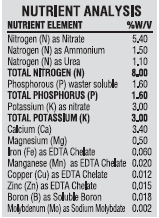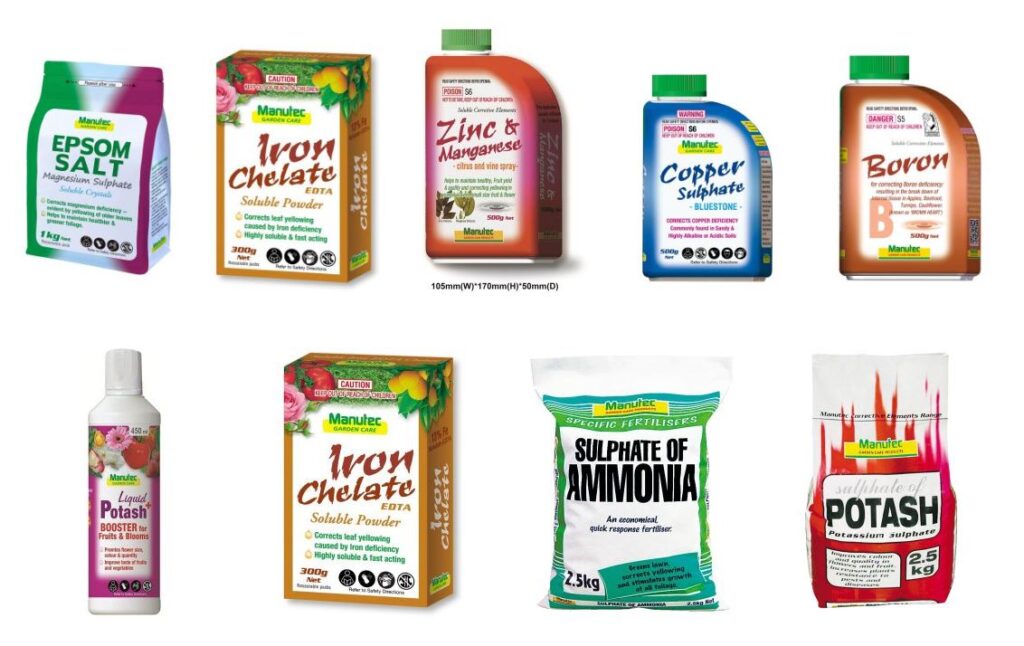What are Plant Nutrients?
Sixteen elements are considered essential nutrients for healthy plant growth.
Of these 16 elements, Carbon (C) Hydrogen (H) & Oxygen (O) are naturally available in adequate quantities deriving from atmosphere & soil water. The remaining 13 nutrients are not adequately present in natural soil or water and hence need to be supplemented through external sources such as soil minerals, organic matter, organic fertilisers, or Inorganic fertilisers.
Depending on relative quantities required by plants, these 13 nutrients are classified as:
- Macro (Major) Nutrients
Nitrogen (N), Phosphorus (P) & Potassium (K) - Secondary Nutrients
Calcium (Ca), Magnesium (Mg) & Sulphur (S) - Micro Nutrients or Trace Elements
Iron (Fe), Copper (Cu), Zinc (Zn), Manganese (Mn), Boron (B), Molybdenum (Mo) & Chlorine (Cl)
Most fertiliser products have been formulated based on these 13 essential nutrients and altered to specific NPK ratios to suit the needs of each plant or plant groups.
Role of Major Nutrients (NPK) in choosing the right fertiliser:
Nitrogen
Plant growth & photosynthesis. Nitrogen is essential for the development of plant leaves, stems, and roots. It helps to increase plant growth and size, and it also enhances the plant’s ability to resist disease and stress.
Phosphorus
Growth and development of plant roots and the formation of flowers, fruits, and seeds. It also helps plants convert other nutrients into usable building blocks for growth. It is essential for the production of ATP (adenosine triphosphate), which is the plant cells’ primary source of energy.
Potassium
Potassium is necessary for the regulation of plant water balance, photosynthesis, and the production of sugars and starches. Potassium helps plants withstand stress, such as drought or cold temperatures, and it is essential for the development of strong stems and roots.
Macro Nutrients are required by plants relatively in larger quantities.
Nitrogen – N: required for growth of foliage, vegetative or green growth
Phosphorus – P: for root development and plant’s energy to uptake nutrients
Potassium – K: for reproductive growth such as flowering & fruiting and also provide pest & disease resistance
Different NPK ratios in fertilisers:
High Nitrogen (N) fertilisers:
These fertilisers contain a high percentage of nitrogen and are ideal for promoting foliage growth. They are often used for lawns, leafy vegetables, and other plants that require a lot of nitrogen to grow.
High Phosphorus (P) fertilisers:
These fertilisers contain a high percentage of phosphorus and are ideal for promoting root growth and flower development. They are commonly used for fruiting plants and vegetables and flowering ornamental plants.
High Potassium (K) fertilisers:
These fertilisers contain a high potassium percentage and are ideal for promoting overall plant health and disease resistance. They are often used for mature plants and those grown in stressful conditions such as drought or extreme temperatures.
Balanced NPK fertilisers:
These fertilisers contain a balanced ratio of all three macronutrients and are ideal for promoting overall plant growth and health. They are often used for general-purpose fertilisation and can be suitable for various plants and crops.
The NPK numbers you see on the back of a fertiliser pack, represents the percent of each nutrient present in that product.
Note, the numbers in the product analysis may not add up to 100 percent as nutrients are expressed as pure element basis and are present in compound form with other trace elements making up that product.
The knowledge of the role and importance of the NPK nutrients helps select the right fertiliser product for the right purpose. For example, as Nitrogen (N) promotes green growth, if you are fertilising lawn or green shrubs, select the fertiliser product with higher Nitrogen content. On the contrary, if you are fertilising rose bushes or fruit plants, select the fertiliser product with higher Potassium (K) content.

Nutrient Uptake by Growth Stage: It is also very important to note that, you will need to apply the right product at the right time. For example, in the beginning, while growing plants take up more nitrogen to put up healthy green/vegetative growth, when plants come to the flowering/fruiting stage, they absorb more Potassium and reduce nitrogen. If you apply Nitrogen rich fertiliser during the flowering stage, plants will put up more green growth and reduce flowering or fruiting. On the contrary, if you apply too much Potassium rich fertiliser when plants are young, it will result in premature flowering or fruiting.
Secondary & Micro Nutrients /Trace Elements: plants require these nutrients in relatively smaller quantities than the previously-mentioned Macro Nutrients, however, they are no less important. A deficiency in Micro Nutrients / Trace Elements can impact a plant’s growth to the same extent as a deficiency in Macro Nutrients.
Types & Forms of Fertilisers
Fertilisers are plants’ food, containing essential nutrients (from either organic or inorganic sources) which is not just chemical-based. Therefore, it is important to feed your plants adequately and regularly for healthy growth. The choice of the best form and type of fertiliser for your plants depends on your application method or convenience as well as your plants’ growing conditions and needs. The below information will help you to understand the various types and forms of fertilisers (with Manutec products as examples) that are commonly available in the market or garden outlets.
Fertilisers Based on Solubility and Nutrient Release
Quick-release Fertilisers
- Liquid Fertilisers
- Soluble Fertilisers

- Easy to apply for soil & foliar spray
- Quick absorption & fast response
- Suitable for quick fix of deficiencies
Slow-release Fertilisers
- Tablet & Spike Fertilisers
- Controlled Release Fertilisers

- Safe with no risk of burning with over dosage
- Gradually release nutrients over a period of time and slow response
- Easy and quick to apply
Fertilisers Based on the Source of Nutrients
Organic-based Fertilisers
- Fish & Seaweed based Fertilisers
- Blood & Bone based Fertilisers
- Manures & Composts

- Nutrients from natural materials like compost, manure, bone meal etc.
- Improves soil heath and is relatively cheaper
- But offers low and limited nutrients
Inorganic-based Fertilisers
- Granular Fertilisers
- Soluble Powder Fertilisers
- Fertiliser Tablets & Spikes

- Nutrients from processed minerals/raw materials
- High in nutrients and provide value for money
- Fast acting but require frequent application
Fertilisers Based on Shape & Form
Granular Fertilisers

- Easy to apply and convenient for busy people
- High analysis & value for money
- Slow response compared to Liquids & Solubles
Soluble Powder Fertilisers

- High analysis & provide value for money
- Fast acting & provide quick fix
- Used quickly and require frequent applications
Fertilisers Based on Plant Specific Nutrition
These specific Fertiliser products are formulated based on the NPK requirements of each plant type or plant group. This makes it easy for users to select the correct product for their plants. However, if ever in doubt, you could use general (all) purpose fertilisers.
A few examples of Manutec plant specific fertiliser products are listed below:
Fertilisers for Roses/Flowers

Fertilisers for Fruit & Citrus

Fertilisers for Lawns

Fertilisers for Orchids

Fertilisers for Tomatoes

Fertilisers for Hydrangeas

Fertiliser Supplements’ Specific Nutrient and Trace Elements
Although natural soils contain most nutrients, a few soil conditions such as acidic soils, alkaline soils, potting mixes or organic soils/composts are low or lack in some nutrients and create deficiencies, particularly in Potassium and Trace Elements, and have to be supplemented. For example, high pH alkaline soils normally experience a deficiency in Iron, Zinc, Manganese etc., whereas acidic soils with low pH commonly become deficient in Major Nutrients such as NPK. This is why it is primordial to test the PH of your soil. Manutec offers specific nutrient fertilisers to supplement and correct individual nutrient deficiencies.

Conclusion
It is important to identify the right type of fertiliser by consulting your local garden experts or garden outlets. No matter the type of fertiliser you decide to use, be sure to read the instructions and follow manufacturer’s advice for better performance and healthy growth. Happy Gardening!

